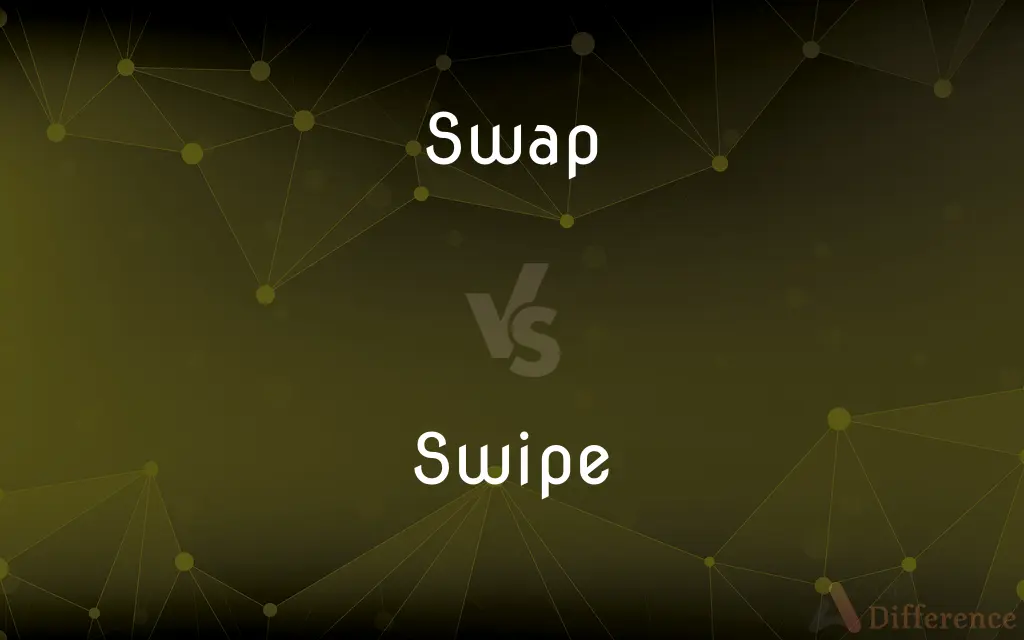Swap vs. Swipe — What's the Difference?
By Urooj Arif & Fiza Rafique — Updated on February 28, 2024
Swap involves exchanging one item for another, while swipe refers to gliding one's finger or an object across a surface, often used in digital interactions.

Difference Between Swap and Swipe
Table of Contents
ADVERTISEMENT
Key Differences
Swap and swipe serve different functions in both physical and digital contexts. Swap is primarily used to denote the act of exchanging items, where two parties agree to trade items of similar value. For example, you might swap books with a friend. On the other hand, swipe is often associated with moving one's finger across a touch-sensitive surface, such as swiping a screen to scroll through a digital interface or swiping a card through a reader.
Swapping involves a tangible exchange, implying a sense of reciprocity or barter. Swiping, when applied physically, relates to a swift, gliding motion, like swiping a card through a machine to make a payment. The physicality of swiping is defined by the motion rather than an exchange.
Swapping can refer to exchanging digital assets, like files, or changing settings within software applications. Digital swiping, however, has become a ubiquitous interaction method for navigating through content on touch-screen devices, embodying a specific gesture rather than an exchange.
The intent behind each action also differs; swapping is motivated by the desire to trade or exchange, aiming for mutual benefit or change. Swiping, by contrast, is about navigation, selection, or activation within a physical or digital space, focusing on the movement required to achieve an outcome.
Both swap and swipe can be applied in digital contexts, their applications diverge significantly. Swapping digital assets requires a mutual agreement or system functionality that allows for exchange, whereas swiping is a solitary action, often part of a user interface design that requires no reciprocal action from another party.
ADVERTISEMENT
Comparison Chart
Definition
The act of exchanging one item for another.
A gliding motion made with a finger or object across a surface.
Context
Can be used both physically (e.g., swapping cards) and digitally (e.g., swapping files).
Predominantly used in digital contexts (e.g., swiping on a touchscreen), but also applies to physical actions (e.g., swiping a credit card).
Purpose
To exchange items, services, or digital assets of perceived equal value.
To navigate, select, or activate something within a digital interface or to perform a physical action.
Action Type
Reciprocal, involving two or more parties.
Singular, involving one person performing the action.
Examples
Swapping books with a friend. Swapping positions in a queue.
Swiping a screen to unlock a phone. Swiping a credit card through a reader.
Compare with Definitions
Swap
Bartering items without using money.
At the swap meet, people swap goods directly.
Swipe
The act of gliding an object through a reader.
Swipe your access card to enter.
Swap
The act of trading places or roles.
The players swap positions during the game.
Swipe
In apps, a gesture for making choices.
Swipe right if you're interested in someone on the dating app.
Swap
To exchange one thing for another.
They decided to swap their lunch items.
Swipe
To move one's finger across a touch-sensitive screen.
Swipe left to see more photos.
Swap
In digital terms, exchanging data or assets.
You can swap files using this software.
Swipe
A quick, sweeping motion.
He made a swipe at the ball but missed.
Swap
A mutual agreement to exchange services.
We'll swap tutoring sessions; I'll teach you math, and you teach me science.
Swipe
Removing or clearing by a quick motion.
Swipe the crumbs off the table with a cloth.
Swap
Take part in an exchange of
We swapped phone numbers
I'd swap places with you any day
I was wondering if you'd like to swap with me
Swipe
The passing of a swipe card through an electronic reader.
Swap
An act of exchanging one thing for another
Let's do a swap
Swipe
Make off with belongings of others
Swap
To trade one thing for another.
Swap
An exchange of one thing for another.
Swap
A contract in which two parties agree to exchange periodic interest payments, especially when one payment is at a fixed rate and the other varies according to the performance of a reference rate, such as the prime rate.
Swap
Exchange or give (something) in exchange for
Common Curiosities
Can you swap services instead of goods?
Yes, swapping can involve services, such as exchanging tutoring in different subjects.
Is swapping always mutual?
Typically, yes, swapping involves a mutual exchange, but it can also occur in digital settings without direct interaction.
Can swipe be used in non-digital contexts?
Yes, swipe can refer to physical actions, like swiping a card through a reader.
What makes a swipe effective in user interfaces?
Its simplicity and the natural motion make swiping an effective tool for interaction in user interfaces.
What is the main difference between swap and swipe?
Swap is about exchanging items or services, while swipe involves a gliding motion, often for navigation or activation.
Are there any platforms dedicated to swapping?
Yes, there are websites and apps specifically designed for swapping items, services, or digital assets.
How do swipe gestures enhance digital interfaces?
Swipe gestures make navigation intuitive, allowing for quick, seamless interaction with digital content.
Can swap and swipe be used interchangeably in any context?
No, their meanings and applications are distinct and not interchangeable.
Can swapping be beneficial in business?
Yes, businesses can swap services or products to mutual benefit, saving costs or expanding offerings.
How has the concept of swiping changed with technology?
Technology has transformed swiping into a fundamental gesture for interacting with digital devices.
What does it mean to swap roles in a team?
It means team members exchange their responsibilities or positions, either temporarily or permanently.
What are the benefits of swapping goods?
Swapping can provide a way to obtain value without monetary exchange, reducing waste and fostering community.
How does swiping a credit card work?
Swiping a credit card through a reader reads the magnetic stripe, allowing for transaction processing.
Is swiping on a touchscreen precise?
Touchscreen technology has advanced to make swiping a precise and responsive way to navigate.
Why is swiping popular in mobile app design?
Swiping fits naturally with handheld device use, offering an efficient way to interact with apps.
Share Your Discovery

Previous Comparison
Academy vs. School
Next Comparison
Pious vs. ReligiousAuthor Spotlight
Written by
Urooj ArifUrooj is a skilled content writer at Ask Difference, known for her exceptional ability to simplify complex topics into engaging and informative content. With a passion for research and a flair for clear, concise writing, she consistently delivers articles that resonate with our diverse audience.
Co-written by
Fiza RafiqueFiza Rafique is a skilled content writer at AskDifference.com, where she meticulously refines and enhances written pieces. Drawing from her vast editorial expertise, Fiza ensures clarity, accuracy, and precision in every article. Passionate about language, she continually seeks to elevate the quality of content for readers worldwide.















































